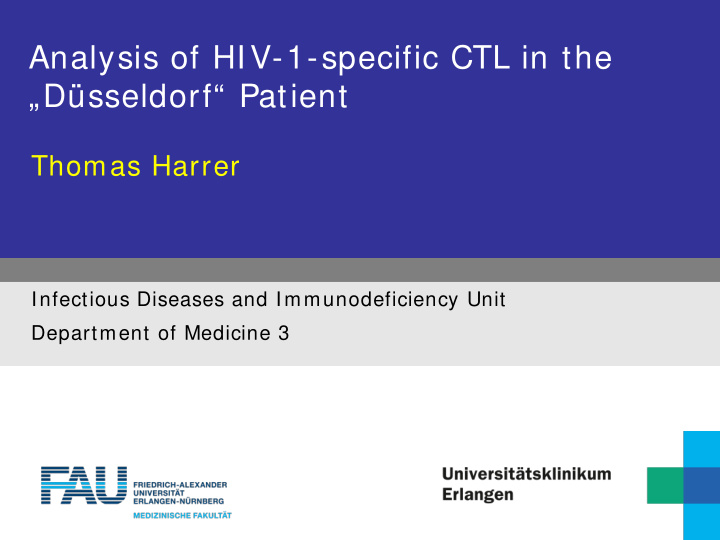



Analysis of HIV-1-specific CTL in the „Düsseldorf“ Patient Thomas Harrer Infectious Diseases and Immunodeficiency Unit Department of Medicine 3
Düsseldorf Patient: HIV-1-specific Immunity? Did the new host develop an HIV-1-specific immunity? High frequencies of HIV-1-specific CTL would indicate active HIV-1 replication and HIV-1 persistence HIV-1-specific CTL could play an important role in the eradicaton of the HIV-1 reservoir 2
Analysis of HIV-1-specific CTL: HLA-I type: A2,A24, B7, C7 ELISPOT with PBMC: PBMC were isolated by Ficoll and rested overnight in R10 ELISPOT with 12 peptides corresponding to known CTL epitopes and two proteins A2: p17-SL9, RT: IV9, VL9, VL9-V, YV9, PR: KI10-M Nef: PL10, PL10-F. A24: gp41-EL9, p24-Il8 B7: Nef: FL9, FL9-T, TM9, RL9, C7: Nef-RY10 20-AA long Gag-Peptides 2 and 5. Proteins: gp120, p24 positive control: PHA 3
Analysis of HIV-1-specific CTL: Results: very weak response to PHA due to immunosuppression no significant specifc response to peptides non-significant reaction to Nef7-FL9 No peptide PHA PHA in other patient 4
Analysis of HIV-1-specific CTL: II Analysis of CTL precursor by peptide stimulation PBMC were stimulated with 6 peptides corresponding to known CTL epitopes in R10 + IL2 Peptides used for stimulation: P17-SL9, RT IV9, RT YV9, Nef-TM9, gp41-EL9, Nef-RY10 Outgrowing cell lines were tested after two weeks for peptide recognition in a γ -IFN ELISPOT assay 5
Recognition of RT-peptide YV9 by peptide stimulated CTL no peptide RT-YV9 peptide no peptide RT-YV9 peptide Blood from 10/ 2015 Blood from 2/ 2016 6
DP: PBMC: d32 1 – H2O ctgcagctctcattttccata catt aaa 2 – CCR5 wt gatagtcatcttggggctggtcctgcc 3 – CCR5∆32 heterozygous gctgcttgtcatggtcatctgctactcg 4 – CCR5∆32 homoygous ggaatcctaaaaactctgcttcggtgt 5 – PBMC patient cgaaatgagaagaagaggcacaggg 6 RTYV9-CTL line ctgtgaggcttatcttcaccatcatgat 7 –Nef-fl9-line tgtttattttctcttctgggctccctaca acattg 8 – GenLadder 50bp (Genaxxon) 9 – Low Molecular Weight DNA DP RT YV9-CTL line: d32 Ladder ( NEB) ctgcagctctcattttccata catt aaa gatagtcatcttggggctggtcctgcc gctgcttgtcatggtcatctgctactcg The RTYV9 CTL ggaatcctaaaaactctgcttcggtgt cGaaatgagaagaagaggcacagg carry the d32 deletion in CCR5 gctgtgaggcttatcttcaccatcatga ttgtttattttctcttctgggctccctaca acattgtccttctcctgaa The RTYV9 CTL are donor derived
Limiting Dilution Analysis: Frequency of RTYV9-specific precursor CTL Serial dilution of PBMC: 10, 100, 250, 500, 1000, 2000, 4000, 8000, 16000 per well + 50 000 irradiated feeder cells + 25 000 irradiated T2-cells loaded with YV9 peptide in R10/ IL2 24 replicates per dilution Elispot-analysis for peptide recognition after 20 and 23 days. 8
Limiting Dilution Analysis: Frequency of RTYV9-specific precursor CTL % + out of 24 replicates ~ 1: 2000 in PBMC 110 100 90 80 70 60 50 40 37.5 % 30 20 10 0 1 10 100 1000 10000 100000 dilution 2000 4000 9
ELISPOT with freshly isolated PBMC: July 2016 No reversion of tacrolimus induced anergy by IL2 and IL7 (100 ng/ ml each) no gamma-IFN-secreting T-cells no stimulus RT YV9 PHA 10
Peptide Stimulation 7/ 2016: stimulation with RT YV9 and with Nef and Gag peptide pools spanning whole Nef and Gag proteins: Nef-Pool 20 peptides 20 aa long peptides with a 10 aa overlap 13 Gag pools with 10 peptides each except for pool 13 with 3 peptides (123 peptides, 15 aa long) Gag pools 10-13 11
Peptide pool 12/ 13 is recognized by CD8+ T-cells Addition of anti-CD8-antibodies blocks T-cell recognition in the ELISPOT assay 12
Epitope mapping peptide pool 12/ 13 1200 1000 800 600 400 200 0 EPID KELYPLASLRS 120 not recognized KE LYPLASLRSL FGN 121 recognized PLASLRSLFGN DPSS 122 not recognized YPL T SLRSLFGN p15-13.2 : weak recognition L Y PLASLRS L A24 epitope Y P LASLRS L B7 epitope 13
The recognized Gag peptide is located in a functional late domain region of p6 late domains promote the release of virus particles from the plasma membrane. The primary Alix binding sequence is located near the C-terminus of p6, between residues 36 and 44 ( 36 YPLASLRSL 44 ) with p6- Y36, L41, and L44 being particularly critical for Gag– Alix binding . 14
Summary I: The donor developed HIV-1-specific CTL against two functional important CTL epitopes in RT and Gag These CTL were not detectable in ELISPOT assays with freshly isolated PBMC presumably due to iatrogenic immunosuppression. The CTL lines showed a strong g-IFN – production despite of prior immunosuppressive therapy 15
Summary II: This indicates that the new donor developed an immune response to HIV-1 surviving transplantation procedure despite strong immunosuppression HIV-1-specific CTL could help to decrease viral reservoirs. 16
Acknowledgment Christiane Mummert Silke Bergmann Björn Jensen Guido Kobbe Rolf Kaiser 17
p6 region of its Gag precursor protein, Pr55 Gag . EPID KELYPLASLRS not recognized KEL YPLASLRSL FGN recognized PLASLRSLFGN DPSS not recognized YPL T SLRSLFGN weaker recognition L Y PLASLRS L A24 epitope Y PLTSLRS L B7 epitope The patient recognizes atleast the B7 epitope probably also the A24 epitope. 18
Recommend
More recommend